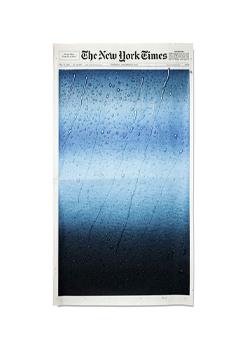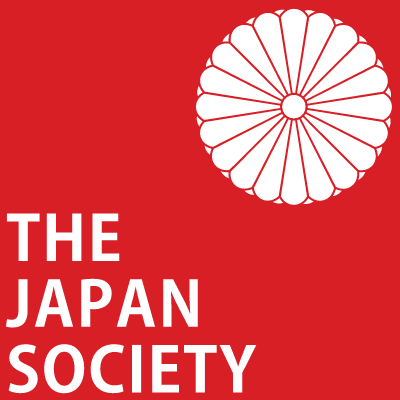Exhibition - Shibuya Sho: Falling from the Sky

Unit Gallery, London
(20 August – 18 September 2025)
Review by Lucy Farley
Every day, Shibuya Sho rises and looks out of his apartment window onto a Brooklyn dawn, photographing the sky overhead for reference. Later, he will purchase a copy of The New York Times from the stand downstairs and paint the morning sky across the front page. This became part of the artist’s daily routine during lockdown, and a selection of the accumulated results of the practice was exhibited at Unit Gallery, Hanover Square. It seems that Shibuya’s art is rarely discussed without reference to the strict regime behind its production – I am reminded of Hokusai’s well-known practice of painting a daily talismanic shishi (Chinese lion), the fame of the routine far outstripping that of any individual work. The collection of Shibuya’s work presented at Unit Gallery was a striking sequence of broadsheet pages, the main columns of text redacted neatly and entirely by squared-off swatches of colours that are vivid against the pulp grey of the paper.
Each sheet, effectively time-stamped by the date on the masthead, offers a window onto any given morning in New York. Just as no two days are the same, the selection spans a huge array of colours and moods: from gradients of deep indigo (Sunday, October 29, 2023) to a shock of molten red (Friday, February 23, 2024) to a delicate dove-grey haze (Thursday, November 9, 2023). But the paintings included in Falling from the Sky all have one thing in common: it is raining. Shibuya has rendered raindrops in a highly realistic trompe l'oeil effect, sometimes as fat spheres that seem to tremble upon the surface of the acrylic paint, sometimes as a crazed delta of wind-blown track marks. These works are beautiful. And it is the beauty of the mundane which the artist seeks to capture: the tranquil sanctuary offered by nature, which is all too often overlooked amongst the noise of everyday existence.
In an interview with It's Nice That magazine earlier this year, Shibuya talked about the inspiration behind this series. He began to paint over The New York Times, he said, ‘almost as if to erase the news with nature, and that kept me sane’. Since then, Shibuya’s work seems to have shifted into a more meditative mode, and then again into a more overtly political one – his most recent works are still in the same ‘The New York Times’ format, but directly cite news stories: a huge, cartoonish broken heart titled ‘BIG, BEAUTIFUL BREAKUP’ on the day The Times reported the split between Trump and Elon Musk; or blackened scraps against a pale gauzy blue titled ‘EVACUATION TO ?’ in reference to the evacuation leaflets dropped by Israeli forces on Gaza. In contrast, this more introverted series takes as its focus the gossamer streaks of a spring shower across a pane of glass, the darkening threat of a sky in an imminent storm. It does, albeit obliquely, still meditate upon the connection between the natural world and the unfolding of global news. In the introductory video played in the gallery’s foyer, the artist reminds us that elsewhere, the sky is not so gentle: ‘It’s not rain that falls, but bombs. Where I see beauty, others see smoke […] These paintings are reminders of what peace looks like. And how fragile it is’.
As I walked around the space, peering onto one New York morning after another, I was struck by the relationship between the brief, five-line weather forecasts left un-redacted on the paper along with the rest of the masthead and that familiar, unchanging Gothic typeface. These forecasts are always different, but naturally use repeated terminology: ‘drizzle’, for example, appears on multiple days, yet the corresponding paintings are diverse: gentle stripes of dusky lilacs and greens on Friday, December 29, 2023 (‘Some drizzle in the morning’), or bright peach bloom set against a dense crackle of steely blue on Monday, March 4, 2024 (‘Morning drizzle’). It serves to demonstrate the limitations of the strictly curtailed forecast in contrast to the complexity of lived experience, ‘shifting and sliding’, to use the artist’s words, like the patterns of rain on glass.
Falling from the Sky was also preoccupied with questions of time, and of control. Artistic production is constant – Shibuya produces a work every morning, rain or shine, but as inclusion in this exhibition was dependent on the condition of rain, curatorial coherence is decided by the elements themselves. In this respect, absences took on meaning too – though this was only a small selection of what must be hundreds of ‘rainy day’ paintings produced (in the video, Shibuya tells us that statistically in New York it rains about 121 days a year), I began to wonder whether the spans of time without a representative painting indicated periods without rain – ‘sunny intervals’ in the exhibition’s scope. The order in which the paintings were hung posed further questions: in an exhibition which otherwise followed a strictly chronological timeline, the decision to reverse this order on one large wall was striking.
This exhibition was an excellent introduction to Shibuya’s work, and offered a tranquil meditation on the importance of fleeting moments of beauty against an ever-shifting backdrop of bad news.

